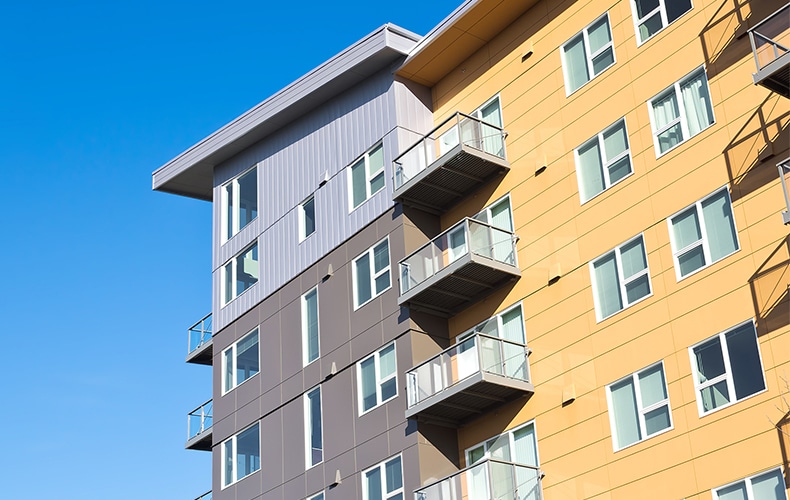As the number of homeowners associations (HOAs) continues to rise, so does the complexity of managing these communities....
What to Know About SB 326: The HOA Balcony Law

This article is provided for general informational purposes only and is not legal advice.
SB 326, passed in 2019, requires HOAs to conduct regular inspections of balconies and other elevated elements to ensure safety. This article breaks down the key requirements and deadlines for California HOA compliance with the “HOA Balcony Law.”
What Is SB 326? A Helpful Overview
SB 326 requires associations to conduct visual inspections of exterior elevated elements and load-bearing components six feet above ground, including: balconies, decks, patios, and elevated walkways. It’s required that a Licensed Structural Engineer or Architect generate a report summarizing the findings, which should then be included in the association’s reserve study.
Inspections are required regularly, and Senate Bill 326 outlines different timelines for both existing associations and newly built condo buildings. For existing HOAs, the first inspection of exterior elevated elements needs to be completed by January 1, 2025. Subsequent inspections need to be completed once every nine years in coordination with the reserve study inspection.
For new condo associations, any new building that had a building permit application submitted after January 1, 2020, the first inspection deadline for newly constructed condos is within six years of getting issued a Certificate of Occupancy. Subsequent inspections have the same cycle as existing buildings (once every 9 years).
Key Requirements for SB 326: The HOA Balcony Law
- According to SB 326 requirements, the inspector must be either a licensed structural engineer or architect.
- The bill requires inspecting a “random and statistically significant sample” of EEEs (95% confidence, error margin ± 5%).
- The bill defines the inspection process explicitly, including defining the term “visual inspection” and permits the inspector to use professional judgment to conduct further inspections.
- The written report must be stamped by the inspector.
Who Performs HOA Balcony Inspections?
A certified professional (either a Licensed Structural Engineer or an Architect) must be the one to conduct the inspection. The three main things they’ll be inspecting are the condition of load-bearing components, the condition of associated waterproofing elements, and an evaluation of expected future performance and projected service life.
Many architects and engineers also employ a qualified waterproofing expert to also be present, in order to ensure the integrity of waterproofing systems for the building are maintained.
Repairs and Maintenance After Inspections
The final report will recommend HOA balcony repairs or maintenance to ensure deck or walkway safety. These recommendations are shared with the homeowners association to assess damages and budget for necessary actions.
There are two types of HOA balcony repairs that may need to be made for SB 326 compliance:
- Non-emergency repairs: The owner or the Board of Directors is notified.
- Emergency repairs: Referred to the Local Building and Safety Department.
Stay Informed with APS Management
To avoid fines and maintain property safety, it’s critical for HOAs to remain compliant with SB 326. APS Management guides HOAs each step of the way. Contact us to help ensure your HOA meets all the legal requirements.
Disclaimer: This information is provided for general informational purposes and should not be considered legal advice.
FAQs About SB 326: The HOA Balcony Law
1. What is SB 326?
A: Senate Bill 326 (the HOA Balcony Law) is a California law that mandates regular inspections of exterior elevated elements, like balconies in HOAs, to preserve public safety. The law was enacted in response to preventable accidents and aims to prevent structural failures through proactive maintenance and inspection.
2. Who can perform the inspections
A: A licensed structural engineer, civil engineer, or architect must conduct the inspections according to state requirements. These qualified professionals must have both the expertise and proper licensing to evaluate load-bearing components and structural integrity.
3. What is the deadline for existing HOAs?
A: To maintain California HOA compliance, the first inspection must be completed by January 1, 2025, with no exceptions for existing properties.
4. How often do HOA balcony inspections need to be completed?
A: Every nine years, in conjunction with the reserve study inspection. This timing allows HOAs to efficiently coordinate maintenance planning and budgeting for both requirements.
5. What happens if my HOA doesn’t comply?
A: Failure to comply with SB 326 could result in significant fines and increased liability risks for the association. Additionally, non-compliance may affect property insurance coverage and expose the HOA to legal vulnerabilities in case of accidents or structural failures.




